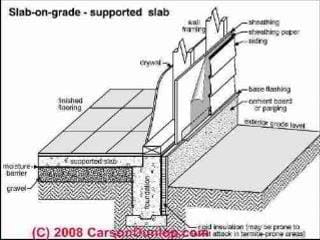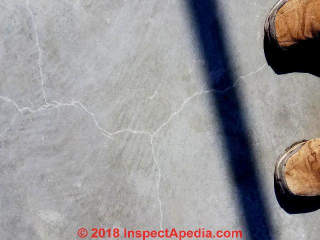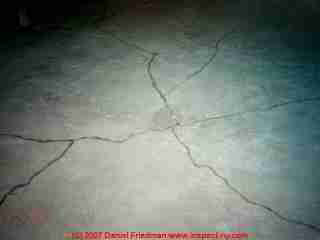 Q&A on Cracks in Poured Concrete Slabs
Q&A on Cracks in Poured Concrete Slabs
Concrete Slab Crack FAQs #4
- POST a QUESTION or COMMENT about cracked concrete slabs and floors
Floor slab & tile crack diagnosis & repair questions & answers set 4.
Some floor slab cracks are harmless or even just "cosmetic" while others may spell trouble ahead.
This article series describes the types of cracks that occur in poured concrete slabs or floors and explains the risks associated with each, thus assisting in deciding what types of repair may be needed.
Page top sketch of a supported slab on grade design is provided Carson Dunlop Associates, a Toronto home inspection & education firm.
InspectAPedia tolerates no conflicts of interest. We have no relationship with advertisers, products, or services discussed at this website.
FAQs: Diagnose & Fix Cracks in Concrete Floors / Slabs
 These questions & answers about the cause, diagnosis, cure or prevention of types of cracks in concrete slabs and floors were posted originally at CONCRETE SLAB CRACK EVALUATION - home - be sure to see that article.
These questions & answers about the cause, diagnosis, cure or prevention of types of cracks in concrete slabs and floors were posted originally at CONCRETE SLAB CRACK EVALUATION - home - be sure to see that article.
Some of these Q&A were also posted first as comments on this page that you are viewing.
[Click to enlarge any image]
Photo: shrinkage cracks in a concrete slab in South Texas, poured / placed in July 2018.
On 2017-04-12 by (mod) - when is an onsite expert needed to diagnose concrete floor cracks
Prashaanth,
Your question needs to be answered by an on-site expert, but it sounds as if there was an improper concrete mix to begin-with, and perhaps lack of reinforcement as well as possible settlement or movement due to flooding.
On 2017-04-12 by Prashaanth
After completion of concreting the slab the next day water was stagnent over the slab for one week .In one place a leak was there .And at top we found a small crack was there but after de shuttering now I found the small crack is at the bottom also .How the crack is formed for the total depth of slab that is 110mm thickness and what will be the reason .How to rectify it?
On 2016-11-11 by liz o
Concrete driveway that slopes slightly from street to garage, approx 20'wide x 20'long (double car width). Two cars park daily on it. Cracks slowly and recently started to appear, they got larger and started to heave. We live in Seattle, the weather is not extreme.
There is a drain hole at base of driveway just before garage. It could be clogged, but I dont think so. House and drive are about 50 years old. Sewer line runs parallel to drive. What could be causing the cracks and heaving. Thanks!
On 2016-10-16 02:58:40.815019 by Mike
We are looking to buy a home. During the inspection they noted a 2.3 inch difference in elevation starting from the front entrance towards the back of the home. No one is able to determine if the foundation is compromised or if the slab was laid with the variance. What type of professional or test must I get ahold of before we commit to buy. Please note that there are no visible cracks or damage throughout the home. Flooring is tile throughout so we are unable to see the actual concrete slab.
On 2016-10-15 23:20:26.624922 by Donal
Great article, answered a few questions I had and learned a few things with it too. I'm looking at buying an older house but I've noticed in the basement main room that there is a damp patch coming up from under the floor in the Center of the room.
Everything else is fine structurally but this patch has me dubious. I cannot figure out what would have caused it, it's 8 ft from the nearest wall and there's no other indication of water/damp. Have you seen this before ?!?
On 2016-10-13 by Mary
My mother is having a patio home built. The new poured concrete slab is extremely rough and bumpy and is now showing two lengthy (about 5 feet) cracks.
The superintendent said roughness was from the concrete getting wet with rain, no mention of the reason for the cracks. He said they would put a layer of epoxy over the concrete and this will fix both issues.
Please advise is this is an acceptable fix. Should we be concerned about significant cracking in the future because of this? Thank you.
On 2016-09-09 by (mod) - slab settlement when floor poured over remains of trees
Lexi that "drop" is possible but speculative. You'd need to have known, or seen photos of the site work at the time the home was built.
There are other causes of settlement and also, in a frerezing climate upifting, such as inadequate compaction of backfill, construction over other debris, expansive clay soils, or water under the slab due to poor site drainage or poor handling of roof spillage.
If I were buying such a house I'd figure the two most essential questions that your inspector should answer are
1. What evidence is there that the movement to date has caused costly or dangerous damage to the building structure, mechanicals, wiring, plumbing, etc.
2. What evidence is there that the movement is ongoing vs. over and done-with?
We discuss the evaluation of those key questions in this article series.
Sometimes there are sufficient visual clues that an inspector, including a home inspector, can be pretty confident about the type and history of slab or foundation movement.
I agree that pouring a slab or building a foundation atop materials that are going to settle, rot, sag or collapse is a very bad idea that is likely to lead to future building settlement and costly damage.
On 2016-09-09 by Lexi
Thank you so much for your time! I live in the northern Indiana area and I was originally told by the general inspector that they have seen similar drops when a home is built over roots of large trees, and when the trees dies and the roots decompose sometimes there will be a drop.
They also mentioned the shifting soil you mention in the above article could be a cause as the home didn't have adequate downspouts sending water away from the home. I will probably have to get the seller to agree to a more in depth inspection.
On 2016-09-09 by (mod) -
Anonymous, I'd want more information to even guess at what has caused the cracking and probably settlement that has occurred in the home you describe. And unfortunately I can't see below your carpets, finish flooring, or slab by e-text.
On a 1963 home a concrete slab on grade floor would of course be common, but construction details would vary depending on where you live, climate, site work, site properties, and other variables. Without more inspection we don't know if the slab is independent of or part of the building foundation.
That's a question to pursue (by excavation if there's no other access).
More important is the question of whether or not this is an ongoing problem or an old one dating from initial settlement when the home was built. An astute inspector with experience can very often find clues indicating the age and history of building movement, as we discuss in this article series.
Search InspectApedia for "age of building settlement" to find two very helpful articles.
On 2016-09-09 by Casey
Thanks again for your time Daniel.
On 2016-09-09 by Anonymous - some of the doors are slightly off because of the slab movement.
I am looking at a home that was built in '63 to purchase. There are no visible cracks to the foundation on the exterior of the home, but when you walk into the master bedroom you can feel a crack in the slab where a portion of it sunk about half an inch to an inch.
When we had our general home inspection, the inspector noticed that there are some diagonal cracks about 1/4 in size in the master bedroom and the room immediately across the hallway from it and that some of the doors are slightly off because of the slab movement.
The only part of the home that has cracks in the walls is right near the bedroom. Any guess of what type of slab this might be/how severe the repair if one is needed?
On 2016-09-07 by (mod) - If settlement continues
Yes watch. If settlement continues at those steps then you may need to repair the step footing. Very slight settlement due to fill compaction may be all that you'll see.
Keep water away as that increases settlement of new construction.
If the steps become noticeably out of level then they become a trip hazard. Stair tread slope (out of level on walking surface) - (slope or "rise" must be <= 1 in 48) - details are at https://inspectapedia.com/stairs/stair_tread_dimensions.php >
On 2016-09-06 by Casey - definable point at which I would want to consider having someone look and act
Daniel,
I appreciate the quick and detailed reply. A couple of follow-up questions/clarifications:
1. It sounds like really the only thing I can be doing at this point is just watching to see if it continues to settle?
2. Do you believe this type of activity after 4-5 months is something I should be looking to remediate with the original contractor\provide negative online feedback for?
3. Is there some definable point at which I would want to consider having someone look at the patio and consider slabjacking or other options? Other than the hairline cracks and that gap there is no noticeable difference in the patio.
Thanks again for your time.
On 2016-09-06 by (mod) - steps settling at stamped concrete patio
Re-Posting:
Anonymous said:
I had a stamped patio installed about four months ago. Recently I noticed that the steps appear to have settled some.
They used to be tight against the house, but there is now about a 3/16" gap. I am wondering if this is anything to be concerned about. I have also noticed some hairline cracks in various places on the patio less then 1/32" wide.
Also, any specific recommendations on how best to seal the gap against the house and the cracks? Thanks for any help.
See link for picture
REPLY
Anon (Casey - as you provide your name at the photo link you gave)
To permit detail and to permit reader comments on your photo I include your original question and our detailed reply at the end of the article above. Please take a look and let me know what questions remain.
Daniel
On 2016-07-17 by jayaprakash43
the informations are very educative for professionals like us, thank you
On 2018-07-23 by (mod) - Effects on Concrete Curing at High Temperatures in Texas
Dale-
Those look like shrinkage cracks to me, too. If there is no settlement and no height difference across the cracks, at the outset these are only a cosmetic concern, perhaps aggravated by the heat.
See your question repeated along with a detailed reply now found at TEMPERATURE EFFECT on CONCRETE POUR. Let me know what questions remain.
On 2018-07-22 by Dale Hart - Poured a new slab 4 days ago during a heat wave in South Texas.
 Poured a new slab 4 days ago during a heat wave in South Texas.
Poured a new slab 4 days ago during a heat wave in South Texas.
We used #3 rebar on 12 inch centers with #5 rebsr with stirrups every 30 inches in perimeter beam. Ground was well compacted. What appears to be shrinkage cracks have begun to appear. We also used a product called Pene-krete that helps hold moisture
I have kept the slab wet continuously. I'm worried although contractor has said these are shrinkage cracks because the heat has caused the slab to cure too soon but he said these cracks or cosmetic only.
The cracks are less than a 1/32 seconds of an inch. what are your thoughts?
On 2016-12-01 by Bill
Earlier post just made. Neglected to mention this construction on compacted sandy and gravel hill in desert area of Nevada. Note that I. Old not send photos in last message.
Let me know how to forward photos if they would be helpful...thanks.
I have a similar issue as anonymous post from Sept 24, 2016. House is a 3600 square foot stressed slab foundation built in 2005.
From my understanding from others, it appears this crack may have been present soon after house was constructed. As seen in the attached photo, the exterior foundation crack appears to run completely through the foundation and is a little more than 1/8 inch.
The crack then crosses in a relatively straight line for approximately 70-feet across the entire width of the foundation and exits the opposite side of the house showing a crack smaller than 1/8 inch.
The tile flooring along the crack line is 3/16 inch and narrows as it gets closer to the opposite side of house. There does not appear to be vertical movement of the slab and it appears the size of this crack is remaining constant. I've noted a few other smaller cracks in other areas, but nothing as significant.
When buying the property, the inspecting engineer referred to the cracks as "shrinkage;" however I continue to worry. Other than the cosmetic issue, is this crack a concern?
If I remove the tile, what is the best form of repair before installing another floor over the slab? Is this a DIY project or a larger project for a contractor?
On 2016-09-25 by Anonymous
A slab was poured and there appears to be a very long crack (transverses 32 feet). Should this warrant a new pour or what?
There has been other slabs poured in the neighborhood with similar albeit not as long cracks. I am concerned because looking from the side in appears the crack runs through the entire depth of the slab.
The flooring to be covering the slab is to be wood (primary) tile in baths,and a little carpeting is bedrooms. This area also has dry desert termite issues.
 Reader question: Reinforce floor slabs in Australia?
Reader question: Reinforce floor slabs in Australia?
(June 20, 2011) Jack Emery said:
In Australia it is mandatory to reinforce concrete floor slabs with galvanised steel mesh which is laid 1 in. from the top of the slab.
This eliminates shrinkage cracking.
Reply:
I don't know Jack and will research the question further. In Australia as in most countries, the local building code official is the final authority so I'd start there.
But in any case, steel mesh won't completely prevent shrinkage cracks that occur as the result of how the concrete was mixed or because of the absence of control joints where needed in the slab. Steel reinforcment particularly helps a slab resist cracking due to heaving or settlement or loading.
Photo above-left: serious cracking and settlement in a concrete floor slab. See SETTLEMENT vs. SHRINKAGE CRACKS for more about this photo.
...
...
Continue reading at CONCRETE SLAB CRACK EVALUATION - topic home, or select a topic from the closely-related articles below, or see the complete ARTICLE INDEX.
Or see CONCRETE SLAB CRACK FAQs-5 - more-recent Q&A about diagnosing and fixing cracked floor slabs
Or see these
Concrete Crack Diagnosis & Repair Articles
- CONCRETE SHRINKAGE CRACKS
- CONCRETE SHRINKAGE CRACK REPAIR
- CONCRETE STAINS: ID & REMOVAL
- CONCRETE SLAB CRACK EVALUATION
- CONCRETE SLAB CRACK REPAIR
- FOUNDATION DAMAGE by MATERIAL or INCLUSIONS
Suggested citation for this web page
CONCRETE SLAB CRACK FAQs-4 at InspectApedia.com - online encyclopedia of building & environmental inspection, testing, diagnosis, repair, & problem prevention advice.
Or see this
INDEX to RELATED ARTICLES: ARTICLE INDEX to BUILDING STRUCTURES
Or use the SEARCH BOX found below to Ask a Question or Search InspectApedia
Ask a Question or Search InspectApedia
Try the search box just below, or if you prefer, post a question or comment in the Comments box below and we will respond promptly.
Search the InspectApedia website
Note: appearance of your Comment below may be delayed: if your comment contains an image, photograph, web link, or text that looks to the software as if it might be a web link, your posting will appear after it has been approved by a moderator. Apologies for the delay.
Only one image can be added per comment but you can post as many comments, and therefore images, as you like.
You will not receive a notification when a response to your question has been posted.
Please bookmark this page to make it easy for you to check back for our response.
Our Comment Box is provided by Countable Web Productions countable.ca
Citations & References
In addition to any citations in the article above, a full list is available on request.
- In addition to citations & references found in this article, see the research citations given at the end of the related articles found at our suggested
CONTINUE READING or RECOMMENDED ARTICLES.
- Carson, Dunlop & Associates Ltd., 120 Carlton Street Suite 407, Toronto ON M5A 4K2. Tel: (416) 964-9415 1-800-268-7070 Email: info@carsondunlop.com. Alan Carson is a past president of ASHI, the American Society of Home Inspectors.
Thanks to Alan Carson and Bob Dunlop, for permission for InspectAPedia to use text excerpts from The HOME REFERENCE BOOK - the Encyclopedia of Homes and to use illustrations from The ILLUSTRATED HOME .
Carson Dunlop Associates provides extensive home inspection education and report writing material. In gratitude we provide links to tsome Carson Dunlop Associates products and services.

